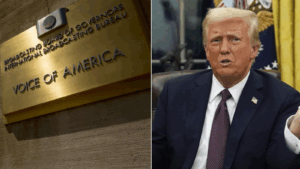The D.C. Circuit Court of Appeals has upheld President Trump's Executive Order 14238, permitting the restructuring of the U.S. Agency for Global Media (USAGM). This ruling emphasizes executive authority and highlights the ongoing debate over the agency's future.
D.C. Circuit Court Backs Trump Administration's Restructuring of USAGM

D.C. Circuit Court Backs Trump Administration's Restructuring of USAGM
The court stayed legal challenges against Executive Order 14238, allowing significant changes at the U.S. Agency for Global Media.
In a significant affirmation of presidential authority, the D.C. Circuit Court of Appeals granted a stay on Saturday, allowing the Trump administration to proceed with its restructuring of the U.S. Agency for Global Media (USAGM). This decision marks a pivotal moment in the administration’s efforts to streamline federal operations and reduce bureaucratic inefficiencies.
Executive Order 14238: A Bold Move to Reduce Bureaucracy
On March 14, 2025, President Donald Trump signed Executive Order 14238, directing USAGM to scale back its operations to the statutory minimum. The order aimed to eliminate non-essential functions and reduce the agency’s footprint, aligning with the administration’s broader goal of minimizing federal bureaucracy.
Legal Challenges and the Court’s Decision
The executive order faced immediate legal challenges, with opponents arguing that the restructuring would undermine the agency’s mission and violate statutory protections. However, the D.C. Circuit Court’s recent stay effectively pauses lower court rulings against the administration, allowing the restructuring to proceed while legal proceedings continue. The court emphasized the executive branch’s discretion in managing federal agencies, reinforcing the president’s authority in this domain.
Implications for USAGM and Federal Media
The court’s decision enables the Trump administration to implement its vision for USAGM, which includes reducing the agency’s size and refocusing its mission. Supporters argue that this move will lead to a more efficient and accountable organization, better aligned with American interests. Critics, however, express concern over potential impacts on international broadcasting and the agency’s ability to fulfill its mandate.
A Victory for Executive Authority
This legal victory underscores the administration’s commitment to exercising executive authority to reform federal agencies. By upholding the president’s directive, the court has set a precedent for future efforts to streamline government operations and reduce unnecessary expenditures.
Executive Order 14238: A Bold Move to Reduce Bureaucracy
On March 14, 2025, President Donald Trump signed Executive Order 14238, directing USAGM to scale back its operations to the statutory minimum. The order aimed to eliminate non-essential functions and reduce the agency’s footprint, aligning with the administration’s broader goal of minimizing federal bureaucracy.
Legal Challenges and the Court’s Decision
The executive order faced immediate legal challenges, with opponents arguing that the restructuring would undermine the agency’s mission and violate statutory protections. However, the D.C. Circuit Court’s recent stay effectively pauses lower court rulings against the administration, allowing the restructuring to proceed while legal proceedings continue. The court emphasized the executive branch’s discretion in managing federal agencies, reinforcing the president’s authority in this domain.
Implications for USAGM and Federal Media
The court’s decision enables the Trump administration to implement its vision for USAGM, which includes reducing the agency’s size and refocusing its mission. Supporters argue that this move will lead to a more efficient and accountable organization, better aligned with American interests. Critics, however, express concern over potential impacts on international broadcasting and the agency’s ability to fulfill its mandate.
A Victory for Executive Authority
This legal victory underscores the administration’s commitment to exercising executive authority to reform federal agencies. By upholding the president’s directive, the court has set a precedent for future efforts to streamline government operations and reduce unnecessary expenditures.





















